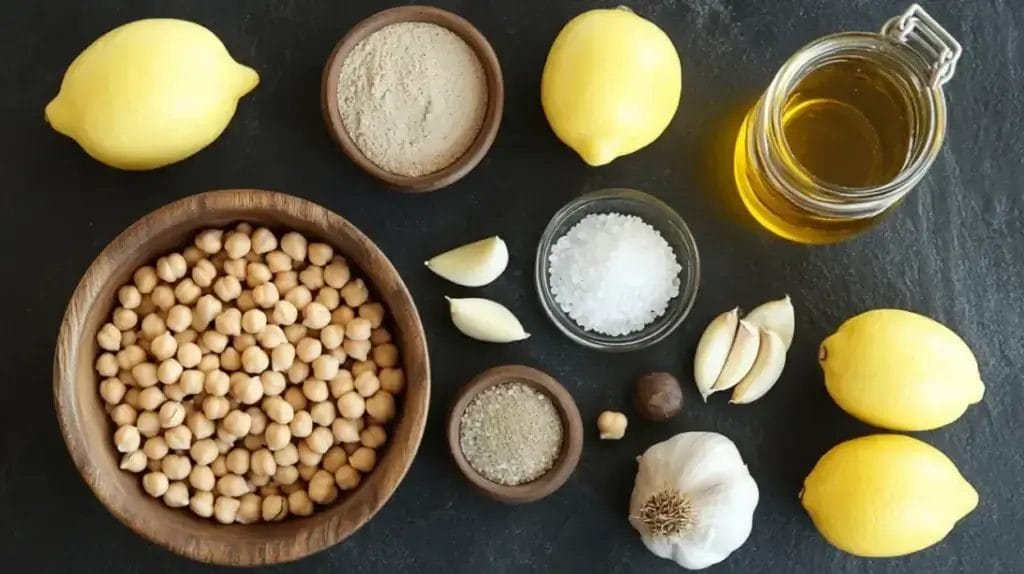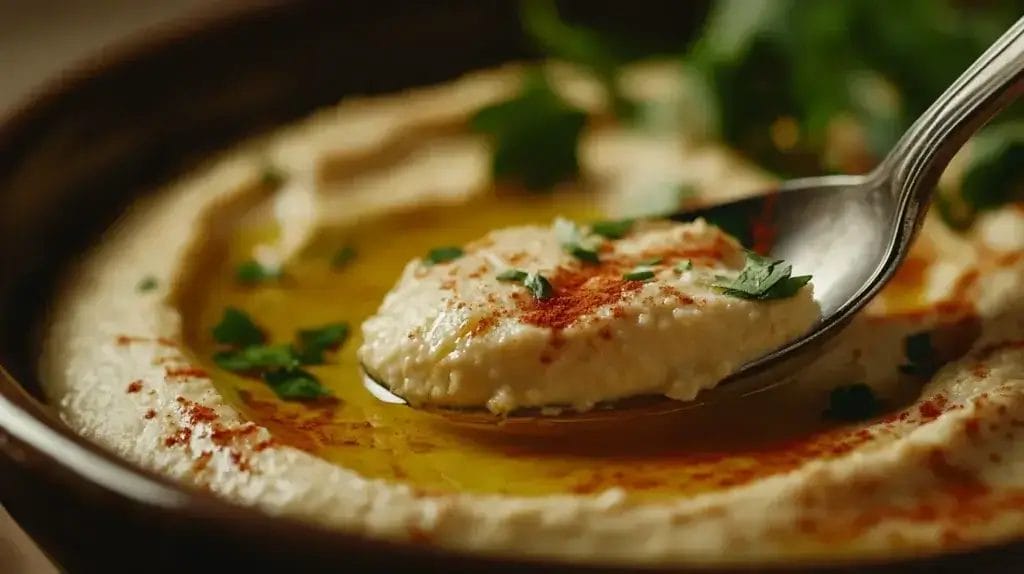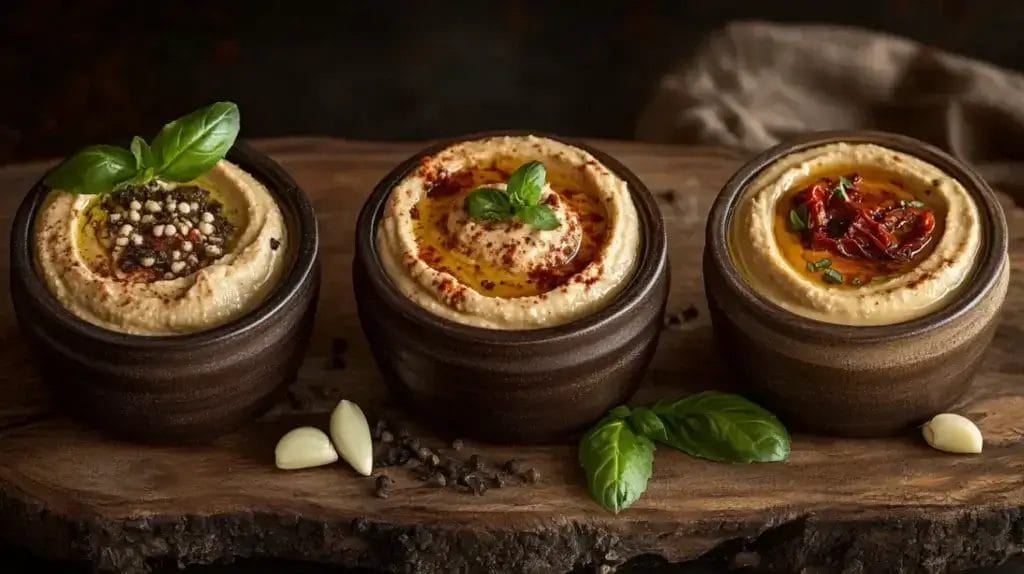Creating the ultimate homemade hummus requires more than just blending chickpeas and tahini—it’s about balance, technique, and patience. This hummus recipe delivers an irresistibly creamy texture with a depth of flavor that store-bought versions simply can’t match.
Using high-quality tahini, freshly squeezed lemon juice, and perfectly cooked chickpeas ensures a smooth, velvety consistency. A hint of garlic and a drizzle of extra virgin olive oil elevate its richness. For a truly authentic touch, let the flavors meld before serving. Pair it with warm pita, crisp vegetables, or use it as a luxurious spread for sandwiches. Every bite bursts with Mediterranean goodness.

Table des matières
Why This is the Best Hummus Recipe ?
A truly exceptional hummus recipe hinges on the harmony of ingredients and technique. This version stands out for its ultra-smooth texture, achieved by simmering chickpeas until they reach a buttery softness. High-quality tahini lends a rich, nutty depth, while freshly squeezed lemon juice introduces a bright, citrusy balance.
A touch of ice-cold water aerates the mixture, creating a pillowy consistency that melts on the tongue. Unlike store-bought alternatives, this hummus recipe uses no preservatives—just pure, wholesome ingredients. A final drizzle of extra virgin olive oil and a dusting of sumac or smoked paprika elevate both taste and presentation. Perfect for dipping, spreading, or enjoying by the spoonful, this authentic rendition honors Mediterranean tradition while offering unmatched creaminess and flavor.
Key Ingredients for Perfect Hummus

The foundation of a flawless hummus recipe lies in selecting premium ingredients that work in harmony.
Start with chickpeas, the heart of this dish. Opt for dried chickpeas, soaked overnight and simmered until buttery soft—they create a smoother, richer texture than canned alternatives.
Tahini, a velvety sesame paste, adds a deep, nutty complexity, essential for authenticity.
Freshly squeezed lemon juice introduces a bright acidity that balances the richness, while garlic, blended raw or roasted, imparts a robust depth.
Ice-cold water is the secret to achieving an airy, almost whipped consistency.
A drizzle of high-quality extra virgin olive oil enhances mouthfeel and flavor, while a pinch of cumin or smoked paprika adds subtle warmth.
Season generously with sea salt to amplify every nuance. This hummus recipe captures the essence of Mediterranean tradition, delivering an unparalleled balance of creaminess, flavor, and depth.
5 Pro Tips for the Creamiest Hummus

Achieving the silkiest texture in a hummus recipe requires precision and a few key techniques.
- Cook Chickpeas Until Ultra-Tender – Simmer chickpeas longer than usual, even past the point of doneness. Adding a pinch of baking soda to the water helps break down their outer skins, yielding a smoother blend.
- Peel the Chickpeas for Extra Creaminess – Removing the thin skins may seem tedious, but it eliminates any grittiness, ensuring a luxuriously soft texture.
- Blend Tahini and Lemon Juice First – Whipping tahini with fresh lemon juice before adding chickpeas creates a fluffy, emulsified base that enhances smoothness.
- Use Ice-Cold Water – A splash of icy water while blending lightens the texture, making the hummus recipe incredibly airy and luscious.
- Let It Rest Before Serving – Allowing the hummus to sit for at least 30 minutes lets flavors meld, creating a more balanced, velvety result.
Master these tips, and every batch will be irresistibly smooth and creamy.
How to Make Hummus from Scratch (Step-by-Step Guide)?
Crafting an authentic hummus recipe from scratch requires patience and the right technique.
- Soak and Cook the Chickpeas – Begin with dried chickpeas. Soak them overnight, then simmer until exceptionally tender. For extra smoothness, add a pinch of baking soda to the cooking water.
- Peel for a Silky Texture – Once cooked, rub the chickpeas between your hands or in a towel to remove their thin skins. This small step results in a velvety consistency.
- Blend the Base – In a food processor, whip high-quality tahini with freshly squeezed lemon juice until light and airy. This emulsification enhances the texture.
- Incorporate Chickpeas Gradually – Add chickpeas in small batches, blending continuously. Introduce ice-cold water to loosen the mixture and create an ethereal fluffiness.
- Season and Finish – Enhance with garlic, cumin, and sea salt. Drizzle with extra virgin olive oil and garnish with sumac or paprika.
This hummus recipe delivers unparalleled creaminess, rich depth, and an irresistibly smooth finish.
How to Fix Common Hummus Mistakes

Even a well-executed hummus recipe can go wrong without careful attention to texture and flavor balance. If the hummus is too thick, gradually add ice-cold water or a drizzle of olive oil while blending. If it’s grainy, ensure the chickpeas are thoroughly cooked and peeled for a smoother consistency.
A bland taste often results from insufficient lemon juice, garlic, or salt—adjust gradually to enhance depth. If the hummus tastes bitter, the tahini quality may be poor; opt for a premium brand. For an extra-creamy finish, blend longer until the mixture becomes silky and airy.
Do You Need to Peel Chickpeas for Hummus?
Peeling chickpeas is the secret to achieving an ultra-smooth hummus recipe. The thin, translucent skins create a slightly gritty texture, preventing the hummus from reaching its full creamy potential. While peeling can be tedious, it significantly enhances the final result.
An easy trick is to soak cooked chickpeas in warm water and rub them between your hands—the skins will loosen effortlessly. For those short on time, adding baking soda to the cooking water helps break down the skins naturally. Though optional, peeling transforms a standard hummus recipe into a velvety, restaurant-quality dip.
How to Make Hummus Without Tahini (Easy Substitutes)
A hummus recipe without tahini is entirely possible while still achieving a rich and creamy texture. Substitute tahini with Greek yogurt for a tangy twist or use almond butter for a mild, nutty depth. Sunflower seed butter provides a similar consistency without overpowering flavors.
For a lighter alternative, blend in olive oil and extra chickpeas, creating a silky, tahini-free base. A touch of toasted sesame oil can mimic tahini’s signature nuttiness. Adjust lemon juice and garlic to maintain balance, ensuring this hummus recipe remains flavorful and smooth, even without traditional sesame paste.
What to Serve with Hummus (Best Pairings & Ideas)

A well-crafted hummus recipe shines when paired with the right accompaniments. Warm pita bread or grilled flatbreads offer the perfect vessel for scooping, while crisp vegetables like cucumbers, bell peppers, and carrots add a refreshing crunch. For a heartier option, spread hummus on sandwiches, wraps, or grain bowls for an extra layer of creaminess.
It also complements roasted meats, falafel, and shawarma, enhancing their savory depth. Looking for a unique twist? Serve hummus alongside olives, feta cheese, or pickled vegetables for a Mediterranean-inspired platter. This versatile hummus recipe pairs effortlessly with countless flavors and textures.
Storage Tips – How to Keep Hummus Fresh Longer
Proper storage preserves the creamy texture and vibrant flavor of a hummus recipe. Always store hummus in an airtight container to prevent oxidation and drying. Drizzling a thin layer of extra virgin olive oil on top creates a natural barrier, keeping it moist and fresh.
Refrigerate at a consistent cold temperature (below 40°F) to slow spoilage. For longer storage, freeze hummus in small portions—simply thaw and stir before serving. Avoid double-dipping to prevent contamination. When stored correctly, a hummus recipe stays fresh for up to five days in the fridge or three months in the freezer.

How to Make Hummus Recipe?
Ingredients
- “1 ½ cups dried chickpeas or 1 can, drained and rinsed”,
- “½ teaspoon baking soda for cooking chickpeas”,
- “⅓ cup tahini”
- “2 tablespoons fresh lemon juice”
- “2 cloves garlic minced”,
- “½ teaspoon ground cumin”
- “½ teaspoon sea salt”
- “¼ cup ice-cold water”
- “2 tablespoons extra virgin olive oil”
- “Paprika or sumac for garnish”
Instructions
- Soak dried chickpeas overnight, then drain and rinse.
- In a pot, simmer chickpeas with baking soda until very soft (about 25 minutes). Drain and peel for a smoother texture.
- In a food processor, blend tahini and lemon juice until creamy.
- Add chickpeas, garlic, cumin, and salt. Blend while gradually adding ice-cold water until smooth.
- Drizzle with olive oil, garnish with paprika, and serve.
Hummus Recipe Variations (Spicy, Roasted Garlic & More!)
A classic hummus recipe serves as a versatile base for endless flavor variations. For a fiery twist, blend in harissa, cayenne, or roasted jalapeños, creating a bold and smoky heat. Roasted garlic hummus brings a mellow sweetness—slowly caramelized cloves infuse the dip with deep umami notes. Sun-dried tomatoes add a tangy richness, while a swirl of pesto transforms it into a herby delight. For an earthy depth, mix in roasted red peppers or cumin-spiced caramelized onions. Experimenting with flavors ensures every hummus recipe remains exciting, catering to every palate with unique textures and aromas.
The variety on account of hummus relies upon the kind of fixing and topping utilized. Kidney beans, parsley, paprika, entire, and entire pine nuts are more customary choices. However, you can likewise try different things by adding caramelized onions, tomatoes, cucumbers, cilantro, mushrooms, and bubbled eggs.
More Delicious Middle Eastern Recipes to Try
Tasty Kielbasa and Rice Recipes for Easy Meals
Healthy Cold Press Juice Recipes You Can Make at Home
Unlock Flavors with Authentic Moroccan Spice Blend

